The right wardrobe system can completely revolutionize not just your bedroom storage, but your entire daily routine and peace of mind.
Most people don’t realize just how life-changing an organized, well-designed closet space can be until they experience it firsthand.
Before discovering the endless possibilities of IKEA’s PAX system, countless homeowners struggle with overstuffed closets, under-bed storage boxes, and the dreaded “chair-drobe” where clothes pile up day after day.
Morning routines become stressful treasure hunts for specific items, while seasonal switches create chaos throughout the entire bedroom.
The versatility and customization options of the PAX wardrobe system have made it the go-to solution for storage dilemmas in bedrooms of all sizes around the world.
The following collection showcases the absolute best PAX designs that combine stunning aesthetics with game-changing functionality – proving that practical storage can also be incredibly beautiful.
✨Click to Get My 101 FREE Designer Room Ideas
The Minimalist Dream: All-White PAX Haven 🤍
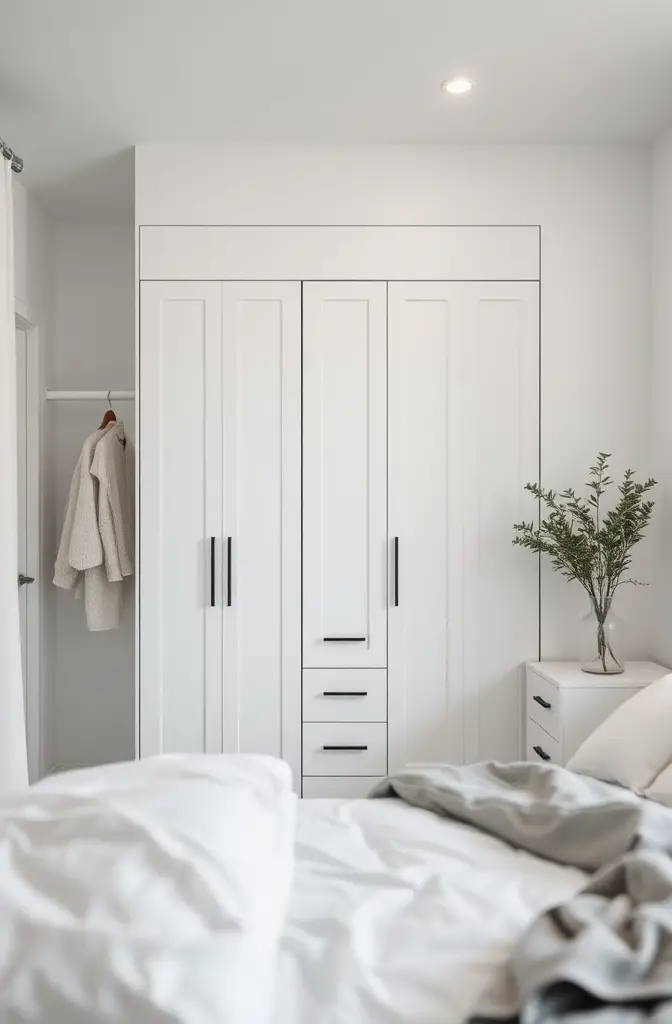

Nothing captures modern elegance quite like a pristine all-white PAX wardrobe stretching wall-to-wall.
This design choice instantly makes your room feel bigger, brighter, and impossibly clean.
The key to elevating this look is choosing high-gloss FARDAL doors that reflect light throughout your space, creating the illusion of even more room.
Don’t be afraid to take your PAX units all the way to the ceiling – this maximizes storage and creates that custom built-in look that will have guests questioning if it came with the house.
For handles, opt for minimal push-to-open hardware or sleek silver bar pulls that won’t interrupt the clean lines.
Inside this white wonder, organization becomes intuitive when you add clear acrylic drawer dividers that let you see everything at a glance.
Consider installing LED strip lighting along the top interior edge – this practical addition transforms into a dramatic effect when you open your wardrobe doors, illuminating your clothing like a high-end boutique.
The beauty of the all-white approach is its versatility; it works with absolutely any interior design style from Scandinavian to farmhouse to ultra-modern.
If you’re worried about too much white feeling cold, introduce warmth with natural woven baskets on the shelves or display a few colorful accessories on an open section.
For the ultimate finishing touch, add a full-length mirror to the outside or inside of one door, eliminating the need for a separate standing mirror and completing the functionality of your wardrobe station.
Remember that white shows dust more easily, so choosing a design with fewer horizontal surfaces (more drawers, fewer shelves) will make maintenance significantly easier.
The visual payoff of this clean, bright, organized sanctuary makes the occasional dusting completely worthwhile.
💯
Dark Drama: Black Oak Veneer with Glass Accent Doors 🖤
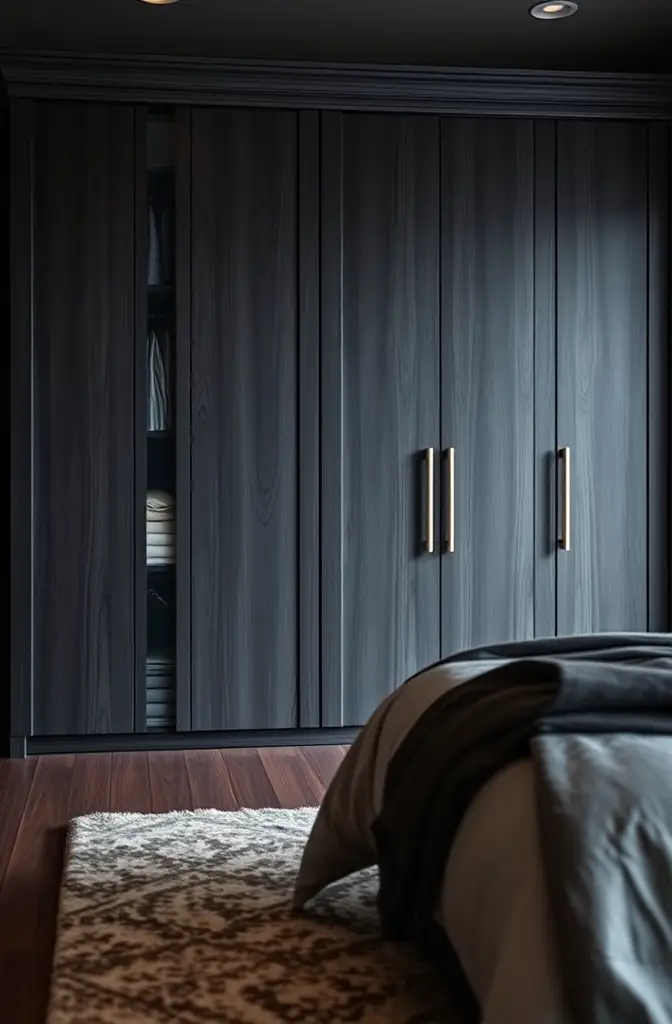

There’s something undeniably sophisticated about a dark wardrobe that anchors a bedroom with its commanding presence.
The black-brown SEKKEN frosted glass doors paired with oak veneer frames create a mysterious, elegant statement that feels both contemporary and timeless.
Unlike lighter options, dark PAX units don’t just blend in – they become a focal point, almost like a piece of fine furniture rather than mere storage.
The beauty of choosing this darker palette is how it showcases what’s inside – your clothing and accessories pop against the deep background, creating visual interest even when the doors are open.
Installing warm LED lighting becomes even more dramatic against the dark interior, creating pools of golden light that highlight your favorite pieces.
For the ultimate luxury touch, line some drawers with velvet inserts in jewel tones like emerald or burgundy to create stunning contrast when storing accessories or delicates.
The glass door panels introduce a beautiful textural element while providing a subtle glimpse of what’s stored inside, eliminating the guesswork of where things are without fully exposing the contents.
This design particularly shines in bedrooms with higher ceilings where the dark vertical elements draw the eye upward, emphasizing the room’s height and creating an expanded sense of space.
If your room gets abundant natural light, this darker wardrobe choice absorbs some brightness, creating a more balanced, relaxing atmosphere perfect for a bedroom retreat.
For hardware, consider matte black pulls that blend seamlessly, or go for the unexpected with brass or gold handles that pop against the dark background like jewelry.
Inside, mixture of hanging space with glass-front drawers allows you to see folded items without opening anything – perfect for quickly planning outfits.
This dramatic look pairs beautifully with almost any color scheme but really shines against neutral walls where it can command attention without competition.
If you’re concerned about the room feeling too dark, position the unit where natural light will occasionally illuminate it, creating beautiful shadow play across its textured surfaces throughout the day.
✨
Open Concept: The Instagram-Worthy Exposed Wardrobe 📸


Sometimes the most stunning wardrobe isn’t hidden behind doors at all.
The open-concept PAX system has taken social media by storm, turning clothing storage into an intentional design element that celebrates your personal style.
This approach transforms your carefully curated wardrobe into living art, where color coordination and thoughtful arrangement become part of your room’s visual story.
The key to making this look sophisticated rather than messy is committing to a cohesive color palette within your clothing collection – think neutral basics with perhaps one or two accent colors that complement your bedroom decor.
Without doors, the frame choices become even more important – consider the KOMPLEMENT white frames for a floating, gallery-like display, or opt for black-brown for more definition and drama.
The beauty of doorless design is the accessibility – no more rushing in the morning to find what you need when everything is visible at a glance.
Built-in lighting becomes non-negotiable with this style, illuminating your clothing from above or within shelving for that boutique display effect that elevates everyday items to showcase status.
To prevent visual overwhelm, incorporate some closed storage elements like drawers for items that don’t need to be on display – undergarments, workout clothes, and seasonal pieces can be tucked away.
One stunning approach is creating a “capsule collection” display area with your most beautiful pieces at eye level, while everyday basics are stored in other sections or drawers.
Uniform hangers are absolutely essential – invest in slim velvet ones in a single color that disappear while allowing your clothing to be the focus.
Consider adding a small rolling ladder if your units extend to the ceiling – not only practical but adds an unexpected architectural element that enhances the custom built-in illusion.
This design works particularly well for fashion enthusiasts who view their wardrobe as a collection worthy of display, or for those who find visual reminders helpful in utilizing what they already own.
The airflow benefits cannot be overstated – without doors, your clothing breathes better, retains fewer odors, and you’ll spot any issues (like moths or mildew) immediately before they become problems.
🌬️
Small Space Miracle: Maximizing Mini Bedrooms 🏠


When square footage is at a premium, the right PAX configuration becomes nothing short of magical.
For tiny bedrooms, apartments, or studio living, a thoughtfully designed compact wardrobe can literally transform how you live in your space.
The secret to small space success lies in going vertical – using every inch of height available to you, even if that means keeping a small step stool nearby.
Sliding doors become your best friend in tight quarters, eliminating the clearance space needed for traditional swinging doors and allowing furniture placement directly in front of the wardrobe when needed.
Consider the HASVIK high-gloss white sliding doors that reflect light and visually expand the room while providing a clean, unobtrusive presence.
Inside, the KOMPLEMENT system truly shines when space is tight – pull-out trays let you see everything at once without digging, while multi-tiered hanging allows twice the clothing in the same vertical space.
Incorporate specialized organizers like the pull-down hanging rail that brings higher rods within reach and then tucks away – perfect for maximizing vertical storage when you’re short on width.
For corners, the PAX corner unit is worth its weight in gold, utilizing awkward angles that would otherwise be wasted space with specialized corner hanging rods.
In truly tiny rooms, consider a shallower 35cm depth PAX frame instead of the standard 58cm – it protrudes less into the room while still providing functional storage for folded items and shorter hanging pieces.
Drawer dividers become even more crucial in compact designs, allowing you to fit more into every available inch without creating chaos.
One particularly clever hack for small spaces is installing a PAX unit behind your bed headboard if floor space allows – this creates a dressing area and room divider in one efficient package.
Mirror-fronted doors perform double-duty in tight quarters, eliminating the need for a separate mirror while visually doubling the perceived size of the room.
If your ceiling height allows, don’t forget the often-overlooked space above the PAX units – adding coordinating KALLAX units or custom boxes creates additional storage for seasonal or rarely-used items.
The psychological benefits of conquering clutter in a small space cannot be overstated – walking into a well-organized room, regardless of size, instantly reduces stress and creates a sense of calm control.
🧘♀️
✨Click to Get My 101 FREE Designer Room Ideas
Family Command Center: The Hardworking Shared Wardrobe 👨👩👧👦


Creating a PAX system that works for multiple family members might be the ultimate organization challenge, but when done right, it’s life-changing for busy households.
The family-focused wardrobe needs to be durability-forward, with considerations for both growing children and adults sharing the same storage ecosystem.
Start by assigning zones within the larger wardrobe system – maybe one section per family member with personalized elements that reflect their specific needs and habits.
For kids’ sections, installing adjustable height hanging rails is genius – they can be moved upward as children grow taller and want more independence in selecting their clothing.
Colorful drawer fronts or different handle styles can help younger children identify their own sections, promoting morning independence and cutting down on the “I can’t find my…” complaints.
Incorporating a mix of open and closed storage acknowledges the reality of family life – some items look display-worthy while others (like the mountain of mismatched socks) deserve to be behind closed doors.
Pull-out hampers within each person’s section eliminate the bedroom floor becoming the default dirty clothes location, while teaching even young kids where laundry belongs.
For shared parent sections, consider his-and-hers sides with specialized storage for watches, jewelry, ties, or scarves based on individual needs.
Label makers become your best friend for shared wardrobes – clear identification prevents morning arguments and helps maintain the system even during the weekday rush.
One particularly brilliant addition is a central “planning station” with pull-out trays where outfits for the next day (or week) can be assembled in advance – a game-changer for school mornings or busy professionals.
Remember to place frequently-used kids’ items at lower heights they can reach independently, fostering self-sufficiency while keeping adult-only items (like delicate clothing or valuables) up higher.
Seasonal rotation becomes crucial for family wardrobes – consider vacuum-seal bags for off-season clothing that can be stored on the highest shelves, freeing up prime real estate for current needs.
Don’t underestimate the power of shoe storage in family systems – dedicated cubbies, racks, or pull-out shoe drawers prevent the dreaded pile-up at the bedroom door.
The ultimate family-friendly feature?
A small built-in bench or stool that pulls out from the base of the unit, giving little ones a place to sit while putting on shoes or helping them reach higher items with supervision.
🪑
Luxury Hotel Vibes: The High-End PAX Experience ✨
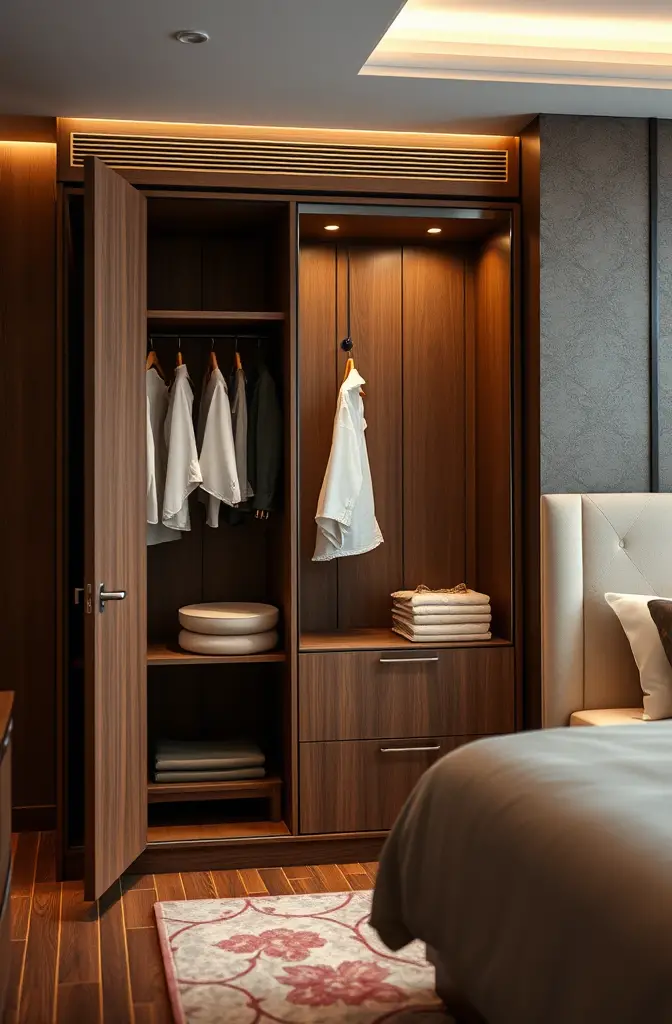

There’s something magical about walking into a luxury hotel closet – that sense of thoughtful organization and elegant display that makes you feel instantly pampered.
Bringing that same energy home is entirely possible with a strategically designed PAX system that focuses on creating an experience, not just storage.
The foundation of luxury closet design is generous breathing room – resist the urge to pack everything in, instead allowing negative space around special pieces that deserve attention.
Select glass-front KOMPLEMENT drawers for your most beautiful folded items, allowing the colors and textures to become part of the visual experience when drawers are closed.
Lighting is non-negotiable in a luxury build – integrate LED strip lighting under every shelf, inside every drawer, and along hanging rods to eliminate shadows and create that coveted high-end boutique effect.
For hanging sections, choose the brass-colored rails rather than standard options – these small details create a cohesive, intentional look that elevates the entire design.
In true hotel style, consider adding a fragrance element – a small diffuser hidden on a top shelf ensures that opening your wardrobe becomes a multi-sensory experience.
The luxury approach privileges specialty organizers – think dedicated sections for watches, sunglasses, scarves, and other accessories that would typically be jumbled together in standard designs.
If space allows, the ultimate luxury addition is a small island or peninsula extending from the wardrobe with a glass top for displaying your most-used accessories or perfume collection.
Don’t forget the power of materials – add leather pull handles instead of standard options, or consider having a carpenter apply real wood veneer panels to the exterior for bespoke sophistication.
For evening wear or special occasion pieces, extra-tall hanging sections with proper supporting rods prevent delicate fabrics from creasing while keeping them visible as part of your personal collection.
Technology integration takes luxury to the next level – motion-sensor lighting that illuminates sections as you approach, or even a small built-in bluetooth speaker for getting ready to your favorite music.
The most important luxury element is often the simplest: empty space.
Having room to add new pieces without reorganizing everything creates the feeling of abundance that defines true luxury living.
💎
Contrast Play: Black and White Graphic Statement 🖤🤍
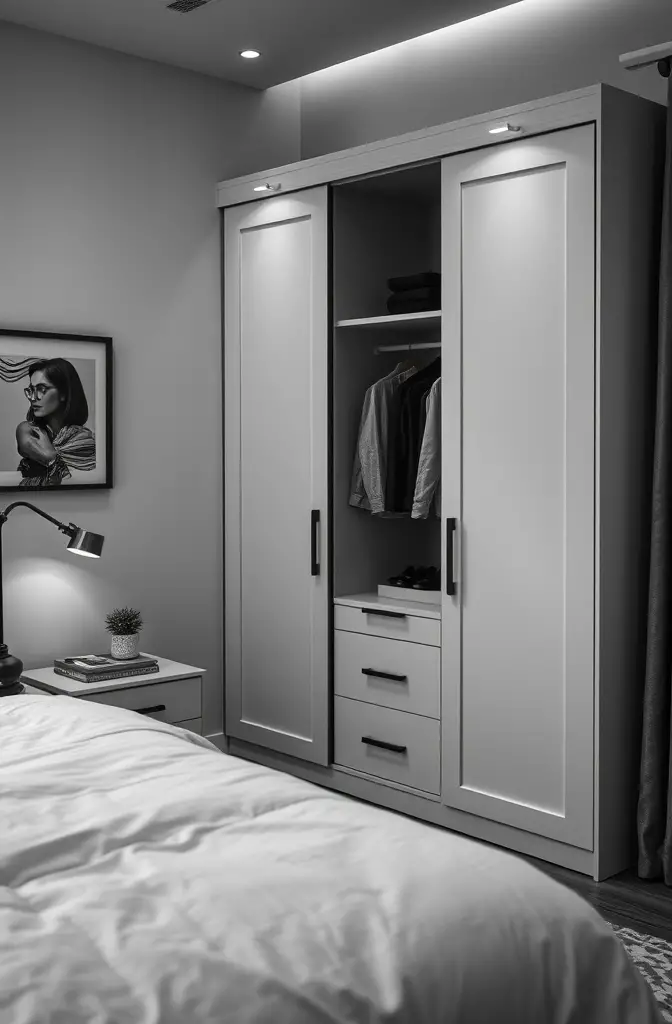
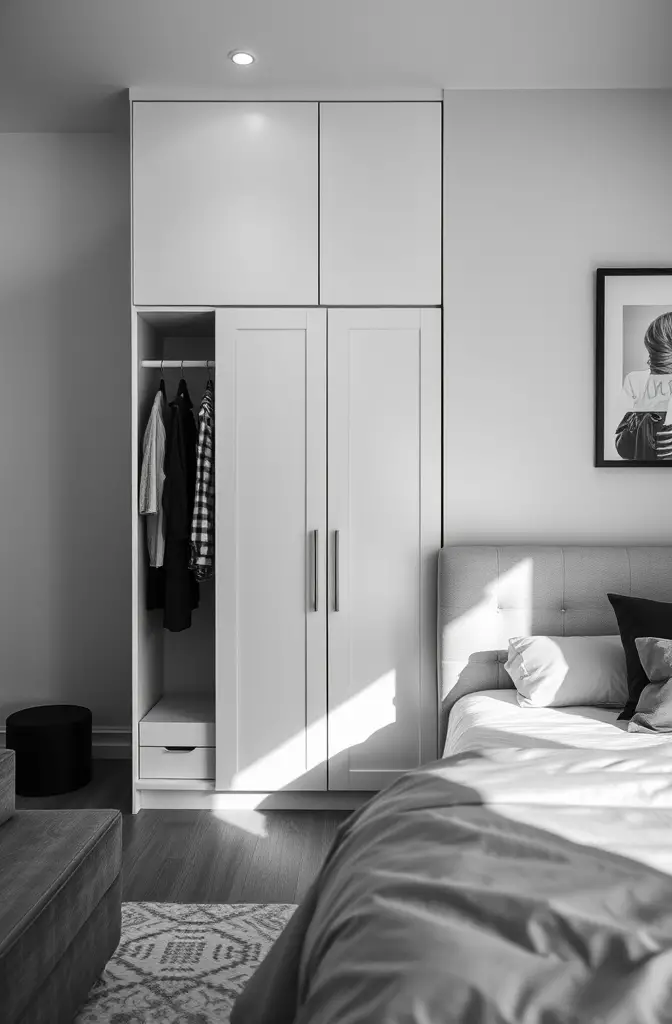
There’s something eternally chic about the high-contrast interplay of black and white that never goes out of style.
A two-tone PAX wardrobe creates instant architectural interest, transforming a basic storage piece into a designed element that anchors your entire bedroom.
Consider alternating FARDAL high-gloss black and white doors for a piano key effect, or go with a more subtle approach using white frames with black drawer fronts for sophisticated punctuation.
The beauty of this contrast approach is its compatibility with virtually any design style – it works equally well in ultra-modern spaces or traditional bedrooms looking for a contemporary edge.
When working with strong contrast, hardware choices become even more impactful – consider matte black handles on white components and silver or chrome on black elements to enhance the graphic quality.
Inside, continue the theme with black velvet jewelry trays against white shelving, or black shelf edges against the white interior for a cohesive experience inside and out.
This design approach particularly shines when you arrange your clothing by color, creating a gradient effect against the stark black and white background – your wardrobe literally becomes living art.
For a truly custom look, consider having a local glass shop cut mirror panels for certain sections, introducing another dimension that reflects and emphasizes the contrast throughout the room.
Lighting placement becomes crucial with high-contrast designs – position LED strips to highlight the boundaries between black and white elements, enhancing the intentional graphic effect.
If you’re hesitant to commit to too much contrast, start with a primarily white wardrobe but add black accents through organizational elements like boxes, dividers, and specialized storage components.
One particularly striking approach is using white exteriors with black interiors (or vice versa), creating a surprising moment of discovery each time the wardrobe is opened.
For the ultimate graphic statement, coordinate other bedroom elements in the same high-contrast palette – black and white bedding, artwork, or accessories create a cohesive design story.
Don’t forget that texture can add nuance to a two-tone design – mixing matte and glossy finishes within the same color creates subtle variation that adds sophistication to the overall look.
Light It Up: Integrated Illumination Systems 💡

Lighting transforms a basic PAX system from simple storage to a breathtaking feature that makes your daily routine infinitely more pleasant.
Strategic illumination isn’t just beautiful – it’s intensely practical when you’re trying to distinguish between similar colored clothing or find specific items quickly.
The game-changing IKEA MITTLED LED lighting strips install seamlessly under shelves, above hanging sections, and along the interior frame to eliminate shadows and dark corners.
For drawer illumination, the motion-activated strip lights that switch on when opened create an unexpectedly delightful moment every time you reach for socks or t-shirts.
Consider installing lighting at varying depths within the wardrobe – front, middle and back – to create dimension and ensure even the deepest corners receive illumination.
The color temperature of your lighting matters significantly – opt for warm white (2700K-3000K) for a cozy, flattering glow rather than cool white that can feel institutional and harsh.
For the ultimate convenience, connect your wardrobe lighting to a smart home system, allowing voice control or scheduling – imagine asking your assistant to “turn on the wardrobe lights” while you’re still in bed.
One particularly effective technique is creating a “spotlight” effect over display sections where you keep your most beautiful pieces or current season favorites.
Don’t underestimate the power of exterior lighting – LED strips installed along the top outside edge create ambient room lighting while highlighting your wardrobe as an intentional design feature.
For those who choose glass or partially glass doors, strategic interior lighting creates a beautiful glowing effect even when closed, adding ambient light to the entire bedroom.
Consider how lighting can highlight architectural features of your design – illuminating the spaces between sections or around a central display area draws attention to the thoughtful construction.
The practical benefits extend beyond aesthetics – proper lighting helps you assess clothing condition, spot stains before wearing, and match colors accurately, especially during early morning hours.
For sustainability-minded homeowners, opt for the sensor-activated options that automatically turn off after periods of inactivity, saving energy while still providing the luxury experience.
Remember that lighting design should consider your daily routine – brightest illumination where you select outfits, softer lighting in areas accessed less frequently, and perhaps a gentle night light feature for late-night access without disturbing sleep.
⚡
✨Click to Get My 101 FREE Designer Room Ideas
Corner Solutions: Maximizing Awkward Spaces 📐

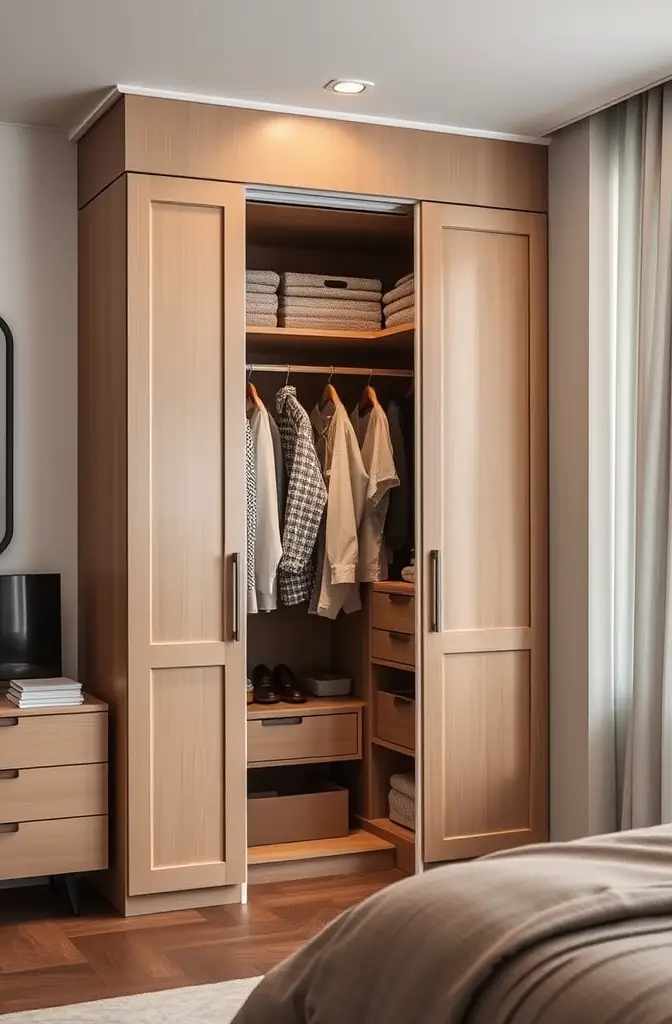
Corners present one of the biggest challenges in bedroom design, often becoming wasted space or awkward dumping grounds for laundry baskets.
The specialized PAX corner unit transforms these problematic areas into organization powerhouses that can actually hold more than standard straight configurations.
The genius of the corner design lies in its angled hanging rail that allows clothing to fan out in a semi-circle, utilizing space that would otherwise be inaccessible with traditional straight rods.
For bedroom corners that can accommodate larger installations, the L-shaped configuration creates a partial walk-in closet feel even in standard bedrooms.
Consider combining a standard depth unit (58cm) on one wall with a shallower unit (35cm) on the other for a configuration that maximizes storage while minimizing intrusion into the room.
The inside corner becomes perfect for hanging longer items like dresses or coats, while the outer sections work beautifully for shorter hanging pieces and folded storage.
If doors are part of your design, the corner presents an opportunity for a unique focal point – consider a different door style, color, or finish for the corner unit to create visual interest.
For an elegant solution, mirrored doors on corner units bounce light throughout the room while providing a full-length reflection that’s perfectly positioned for outfit checks.
Inside corner units, opt for pull-out accessories like the KOMPLEMENT wire baskets that extend fully, eliminating the frustration of reaching into deep corners.
One particularly clever approach is creating a dressing nook within the corner configuration – a small seat, mirror, and surface for getting ready transforms the space into a functional beauty station.
For rooms with architectural challenges like sloped ceilings or odd angles, the corner PAX becomes even more valuable, as its modular nature allows for customization around these fixed elements.
The visual weight of a corner unit actually helps balance rectangular rooms by softening harsh angles and creating a more cohesive flow throughout the space.
If floor space is limited, consider a floating corner design with wall-mounted components, freeing up the floor beneath for other furniture or simply creating a less bulky appearance.
Remember that corner installations often become the natural focal point of a room, so this is the perfect location to showcase your most visually appealing storage solutions or display your favorite accessories.
🔄
Walk-In Wonder: Transforming Small Rooms into Closets 👗

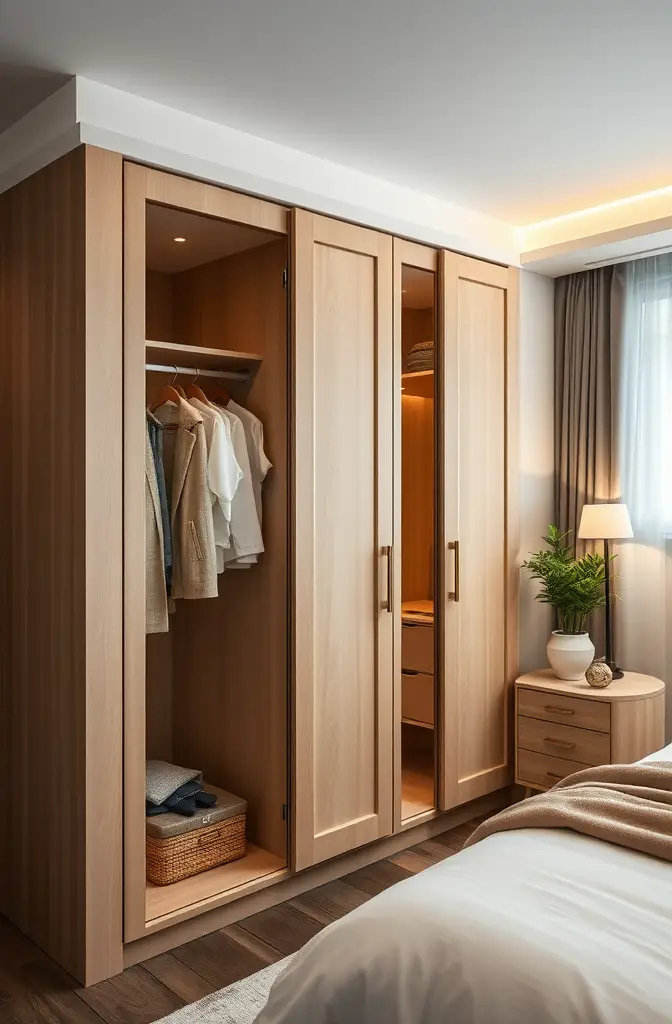
That spare bedroom or awkward bonus space might be the wardrobe of your dreams waiting to happen.
Converting an entire small room into a PAX-based walk-in closet creates the ultimate luxury – a dedicated dressing space where organization reigns supreme.
The key to room conversion success is treating the walls as your frame – installing PAX units against all available wall space while leaving the center open for movement and possibly an island.
Unlike standard closets, a room conversion allows for a mix of depths – use full-depth units where space permits, and shallower versions where walkways need to remain generous.
Consider removing doors from some or all units in a room conversion – with an entire dedicated space, open storage becomes more practical and creates a boutique-like environment.
Incorporate a variety of heights within the design – full-height units along most walls, with strategic lower sections that can serve as display areas, folding stations, or even vanity spaces.
Seating becomes non-negotiable in a walk-in design – whether a luxurious center ottoman, a small bench under a window, or a dedicated vanity chair for getting ready.
Lighting should be approached on multiple levels – ambient room lighting from overhead, task lighting within the PAX units, and accent lighting to highlight special collections or display areas.
For the ultimate luxury, consider replacing a basic ceiling fixture with a statement chandelier or pendant that elevates the entire space from functional closet to personal boutique.
Window treatments require special attention in wardrobe rooms – UV-filtering options protect clothing from sun damage while still allowing natural light to illuminate the space beautifully.
In room conversions, the floor becomes an integral design element – consider upgrading to a plush carpet, elegant hardwood, or even a patterned tile that makes the space feel intentionally designed.
For a cohesive look, paint the walls between and above PAX units in a color that either matches the units (for seamless integration) or provides beautiful contrast (for architectural interest).
Don’t forget the back of the door – this prime real estate can hold hooks, over-door organizers, or even a full-length mirror to maximize functionality of every square inch.
The psychological benefit of a dedicated dressing space extends beyond organization – it creates a daily ritual of self-care and intentional dressing that starts each day on a positive note.
👑
Kid-Friendly but Make It Stylish: Growing Wardrobes 🧸

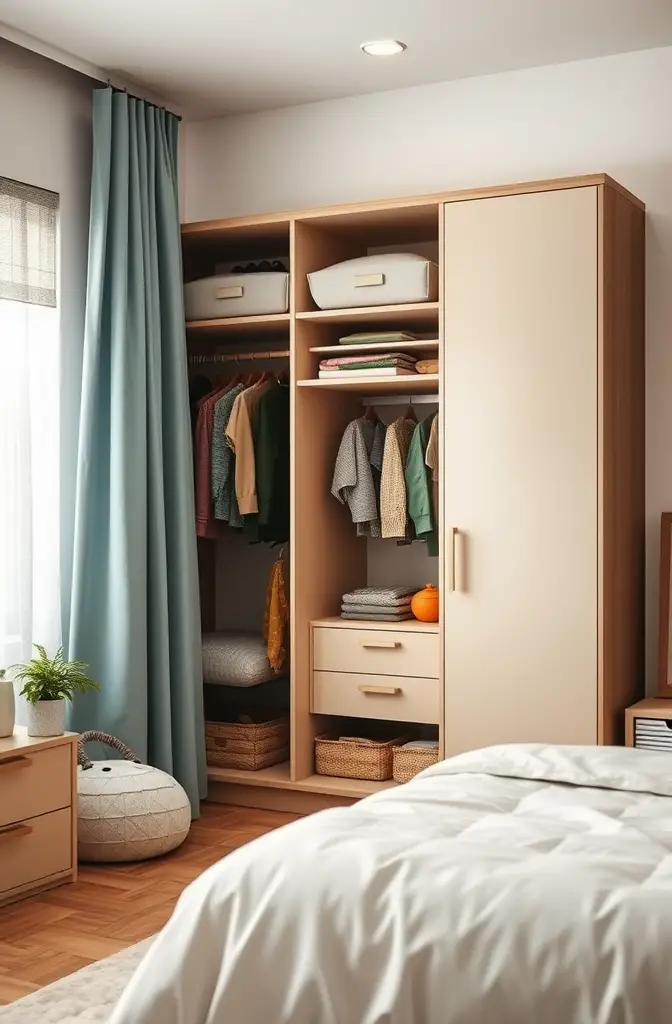
Designing a PAX system for children presents a unique challenge – creating something that works for their current height and needs while building in adaptability for rapid growth.
The magic of children’s PAX designs lies in adjustability – hanging rails, shelves, and organizers that can be easily reconfigured as your child grows from toddler to teen.
Consider installing double hanging rails initially – one at toddler height for them to reach, and one higher up for longer items or parent access, knowing the lower one can be removed and repositioned later.
Color becomes an important tool in kid-friendly designs – using colorful drawer fronts or even applying removable wallpaper to door panels creates a playful environment that can be updated easily.
For younger children, incorporating picture labels on drawers and bins helps foster independence and cleanup skills long before reading becomes reliable.
The beauty of the modular system shines particularly bright for kids’ spaces – start with fewer units that serve immediate needs, with the ability to add components as clothing sizes increase and storage requirements change.
Create a dedicated “dress up” section for younger kids with costumes and special occasion clothing on display – this encourages imaginative play while keeping favorite items accessible.
For school-aged children, a “weekly outfit” system with labeled dividers for each day revolutionizes morning routines and teaches planning skills that last a lifetime.
Incorporate growth tracking directly into the wardrobe by marking height measurements discreetly on an interior panel – a meaningful memory-keeper hidden within a practical piece.
Consider lower open shelving for shoes and daily favorites, with less-used seasonal items and parent-controlled clothing (like expensive coats or special occasion wear) stored higher up.
One particularly brilliant addition for kids’ rooms is a pull-out step that tucks away when not in use but provides safe access to slightly-out-of-reach items without requiring parent assistance every time.
For shared children’s rooms, color-coding becomes even more valuable – assign different colored bins, hangers, or drawer fronts to each child to prevent arguments over whose is whose.
Don’t forget to plan for the teenage years by including some “display” areas for the treasured items, photos, and memorabilia that will inevitably become important as they develop their identity.
The ultimate kid-friendly feature combines function with fun – a full-length mirror on the outside or inside of a door can be framed with string lights or personalized with removable decals to grow alongside them.
🌈
His & Hers Harmony: The Shared Couple’s System 💑
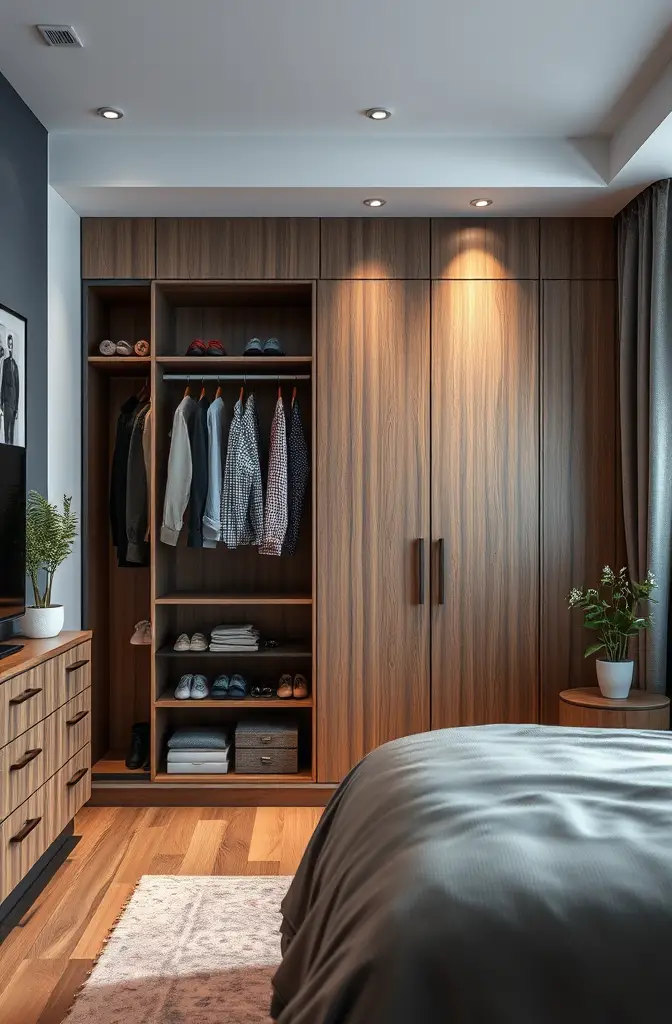

When two adults share one wardrobe, thoughtful design becomes the difference between daily frustration and peaceful coexistence.
The couple’s PAX system ideally starts with honest conversation about storage needs, daily routines, and personal organization styles before a single component is selected.
Consider a visual dividing line – either through different door styles, internal organization systems, or simply a clear spatial separation that respects each person’s territory.
Shared wardrobes benefit enormously from built-in hampers – separate compartments for each person’s laundry prevents the “whose is this?” question and streamlines washing day.
Storage allocation rarely works as a perfect 50/50 split – be honest about who needs more hanging space, who has more shoes, or who requires specialized storage for collections or hobbies.
For couples with significant height differences, customize hanging rod heights accordingly rather than compromising with a middle ground that works poorly for both.
One particularly successful approach is creating specialized zones based on clothing type rather than person – all formal wear together, all casual wear together – while still maintaining personal sections within those categories.
Consider how timing affects usage – if you both get ready simultaneously each morning, ensure the design allows two people to access different sections without colliding.
For accessories, create a dedicated “shared resources” section for items you both use – like suitcases, seasonal gear, or special occasion accessories – with clear organization systems.
Incorporate personal touches within each zone – special hooks for treasured items, display areas for watches or jewelry, or custom solutions for hobby equipment that might otherwise create clutter.
Lighting needs often differ between partners – install adjustable or separately controlled lights that can accommodate one person getting ready while the other might still be sleeping.
For peaceful cohabitation, consider sound-dampening features like soft-close drawers and doors, especially if partners operate on different schedules or one is a lighter sleeper.
The ultimate luxury in shared wardrobes is a central island or peninsula with surface space for folding, outfit planning, or even just placing a coffee cup during the morning routine.
Remember that compromise doesn’t mean identical allocations – the goal is for both people to have a system that works perfectly for their specific needs, even if those solutions look very different from each other.
❤️
✨Click to Get My 101 FREE Designer Room Ideas
Room Divider Magic: The Freestanding Statement 🏡


When architectural walls don’t exist where you need them, a strategic PAX installation creates defined spaces while providing storage – the ultimate multifunctional solution.
The freestanding room divider approach works brilliantly in studio apartments, lofts, or even large bedrooms where you want to create a dressing area separate from the sleeping space.
For maximum stability, secure ceiling-height units to the floor and ceiling even though they aren’t against a wall – this prevents any wobbling while creating the illusion of a permanent architectural feature.
Consider accessibility from both sides when possible – this might mean back panels on only the middle sections, allowing some components to be reached from either the bedroom or dressing area.
Sliding doors become particularly valuable in room divider installations, eliminating clearance concerns while adding a sleek architectural element to both sides of the newly created “wall.”
One particularly effective approach is creating a half-wall with wardrobe units topped with open shelving – this allows light to flow between spaces while still providing visual separation.
Think carefully about which direction doors should open based on the flow of both spaces – ideally, they should never block pathways or other furniture when fully extended.
For room dividers, the back panels become as visually important as the fronts – consider upgrading to finished panels, applying wallpaper, or painting them to coordinate with the room they face.
Strategic placement of mirror-fronted sections can bounce light between newly divided spaces, preventing either side from feeling dark or confined after the division.
If dividing a larger bedroom, consider creating a U-shaped configuration that forms a walk-in closet on one side while defining a sleeping area on the other – the ultimate space transformation.
For studio apartments, a PAX room divider that incorporates a mounted TV bracket on one side creates a media wall for the living area while providing bedroom storage on the reverse.
Don’t overlook the ends of room-dividing units – these become prominent visual elements that can be customized with decorative panels, used as display space, or fitted with narrow shelving for books or accessories.
The psychological benefit of clearly defined spaces enhances both function and feeling – separated areas for sleeping, dressing, and living create natural transitions in your daily routine.

